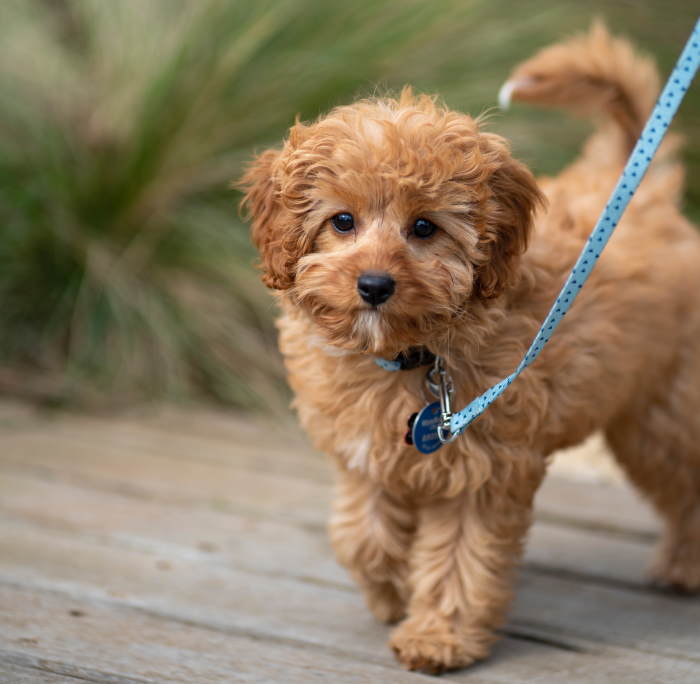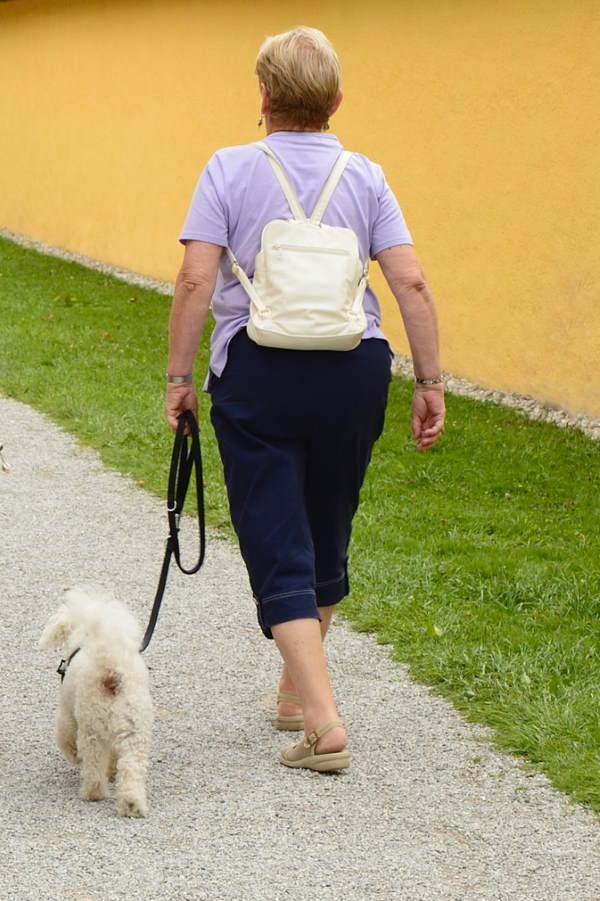- Small Dog Place Home
- Training
- Perfect Heel
The Perfect Heel for Your Dog: Teach Your Dog to Walk on a Leash
Perfect Heel |Updated 11-26-2023
The heel has always been the favorite obedience command for many dog owners. And for good reason. It allows the dog handler to enjoy a walk while looking impressive.
The only thing is, it's complicated. I mean, just think about how unnatural it is! You're asking a little four-legged animal to stand next to you!
Well, I'm going to teach you how to do the basics right now. And there will be no luring required. So, no pointing your fingers to your side or any of that.
 Perfect Heel Photo by Lawrence Makoona on Unsplash
Perfect Heel Photo by Lawrence Makoona on UnsplashWhat You Will Need For the Perfect Heel
Make sure you get these few things before beginning this easy session with your dog.
- Variety of treats: chicken, hot dog pieces, treats from a bag, cheerios, etc.
- Pouch: to hold treats and fast access.
- Leash: Only to prevent your dog from drifting away.
- An environment that is free of major distractions. Although you will start outside!
Getting your Dog to Heel
Start your session outdoors. In the driveway or the front street, if it's not busy. Also, make sure your dog is hungry. If you need to skip part of his breakfast, do it.
How to Use the Leash
Don't worry, you won't have to be a master dog handler for this! But do grab a leash to control your dog.
To manage him, don't allow him to pull you anywhere. Or the leash to pull him into heel position, either. It's only to keep him near you.
How to Position the Treats for the Perfect Heel
This part is so exciting for me! And it will be for you, too.
Shaping is the route we will take. This will work for "heel" because we only want our dog to walk next to us.
So then, we're not exactly preparing for a competition.
- Now, get your dog in the right spot by placing a treat behind your left heel. The food can be behind you up to one foot. I should mention: your dog should see you releasing the food on the ground.
- Don't worry! You are not waiting for your dog to go into a perfect position!All you have to do is let your dog go for the treat. And once he does, you take one normal step forward, leaving him behind.
- Now, leave another treat behind your left foot again, like before. And do this before he has a chance to leave the position he was just in.
If he breaks the position before he sees your new treat on the ground, just wait and toss another treat in the right spot. He will come for it.
Continue the same technique. He will see that you are predictable and catch on.
Move like you mean it. Stay one step ahead of him. And before you know it he won't want to leave or pass you.
 Attempting the Perfect Heel
Attempting the Perfect HeelUnderstanding Your Dog's Body Language
You don't have to be a behavior expert to observe your dog for this session. But you will need to watch for a little detail.
For example, is your dog interested in something else? Or is he engaged with you?
Dogs are fast at reading body language. If you stay calm and stick with the techniques, he will notice. And when he does he will relax a little more. Then he will be more focused.
At this point when he's more locked in, add more steps.
How to Add Steps Towards the Perfect Heel
Let's start bringing this heel to life!
Up until now you have been practically "stealing" steps. But now you're going to ask more of your dog.
The next time you drop a treat, don't step forward. Just stand there.
Did your dog eat and run? Did he wait for another?
If he did break the position, be patient. Almost like a statue. He should return. And when he does, carefully drop a treat behind your heel and step forward.
If he waited and did not pass, simply build a duration of a few seconds before stepping forward again.
Your goal is to accumulate time with him standing behind you. And if he gets distracted, to return to you.
At this point, he should see your side as a valuable place to be.
How to Strengthen your Perfect Heel
Now that your furry little buddy notices how valuable the back of your heel is, it's time to increase the number of steps even more! This is where it would normally get tricky. But today it won't be that way. I'll just tell you plainly.
How to Get 4 Steps
Up to this point, I instructed you to put a treat behind your left heel, and as Fido goes for it, to take a big step forward. And so on.
Now, let's crank it up.
Instead of one step forward, take two. Don't: try to sneak two steps as he goes for the treat.
Do: wait for him to eat the treat. And right as he lifts his head up, take two big steps forward. Do this at a normal pace. If he delays, be patient.
If he passes you, hold still.
Give him up to 20 seconds to go behind you. If he doesn't go behind you, let him see you dropping another treat behind your heel. If he does go back there, repeat the exercise.
Once he does this three repetitions consecutively, add another step to your arsenal. So, in that case, you would then take three steps at a time.
Do this until you get up to four steps. You will find that this is easier than you think. You will be tempted to add more steps. Don't make that mistake.
From 4 to 9 Steps in Seconds for the Perfect Heel
Now, why not exceed 4 steps per reward?
It's because your wee doggie will become uninterested. More steps are a lot to ask for one treat. Besides, if that were not the case, your patterns would become too predictable.
To get more steps immediately, switch to a variable ratio in the amount of feet that move forward.
What is a variable ratio? Well, It's simply an irregular pattern. It's also how casinos get people addicted. So harness the power and take advantage!
Instead of four steps, do one. Then six. Then two. Then 9!
Here is an example of a list of numbers to give you a flow: 1,3,7,2,9,2,5,4,1,8.
Can you see numbers already climbing by the end of this list? And so after that give your boy a break for a minute and raise the average just a little. You will see your dog give up trying to learn your pattern and just walk behind you.
How to Heel Anywhere
Ok, so you made it this far. Very good! But this is a controlled setting, to some degree. We still want your little one to perform out in public.
Once you get your dog into new areas, you may quickly see his training fall apart. And so you say: Wait. What. But I thought …
But don't worry! It will appear that your dog is going backward but really he's learning more. If you don't give up, that is.
Harnessing the Power of Distance
To truly get your dog to walk well in a new environment, you need to make sure he's doing good from afar, first.
How far? Your dog can answer that better that I can.
To gauge this, go away from things that make your dog pull. Get to the point where he can view the object but not be excited.
Train in that general vicinity and when he's calm, move closer. When his tail starts to wag and breathing goes up, mark that area with a mental note. Then reverse. Go back down the sidewalk and work with him some more.
He will become stimulated from the focus, then get closer again.
Over a short amount of time he will do better, even with new environments!
And of course you should see by this time, you should be using less food rewards. You will actually get less results with more food.
Conclusion & Remarks About the Perfect Heel
This exercise is almost entirely positive reinforcement. And when you train like this there can be limitations. For example, some breeds are genetically prone to intense reactivity, like the Jack Russell.
This article is not a one size fits all. Because every little doggie is different. There are humane ways to use tools for practical purposes. But for many tiny rascals this exercise is worth learning. And you'll get a grasp on reinforcement schedules, too!
Author Bio (The Perfect Heel for Your Dog: Steps to Success)
The professionals at Executive Dog Training in Cherry Hill, NJ specializes in dog aggression and emphasizes humane methods. Check out these training videos for "heel" and other commands."
How to Stop a Dog From Jumping On You and Everyone Else
About Janice (author and voice behind this site)
Janice Jones has lived with dogs and cats for most of her life and worked as a veterinary technician for over a decade. She has also been a small-breed dog breeder and rescue advocate and holds academic training in psychology, biology, nursing, and mental health counseling. Her work focuses on helping dog owners make informed, responsible decisions rooted in experience, education, and compassion.
When not writing, reading, or researching dog-related topics, she likes to spend time with her six Shih Tzu dogs, her husband, and her family, as well as knitting and crocheting. She is also the voice behind Miracle Shih Tzu and Smart-Knit-Crocheting
Does This Article Deserve Your Thumbs Up?
We always appreciate your support and encouragement. Your thumbs up means so much to us. Please like this article.
If you find this page or any page on Small Dog Place Helpful, or useful in anyway, I'd love it if you would click the small heart found on the bottom right of each page.
You can also share or bookmark this page -- just click on the:

Free Monthly Newsletter
Sign Up for Our Free Newsletter and get our Free Gift to You.
my E-book, The Top 10 Mistakes People Make When Choosing a Dog (and how to avoid them)







